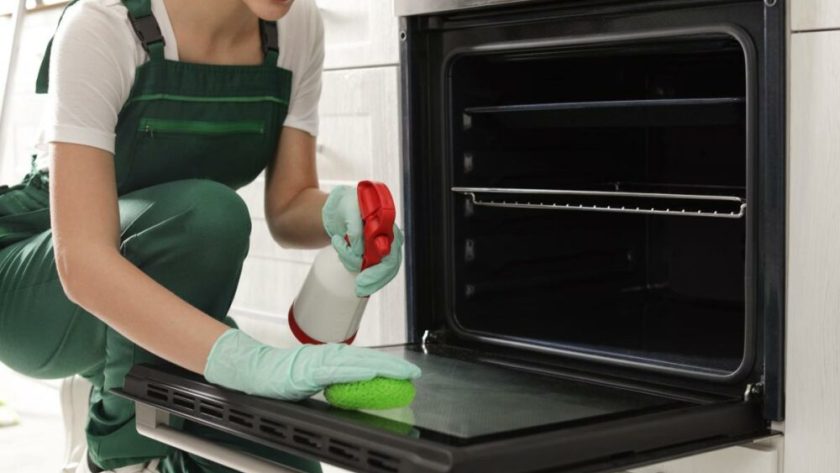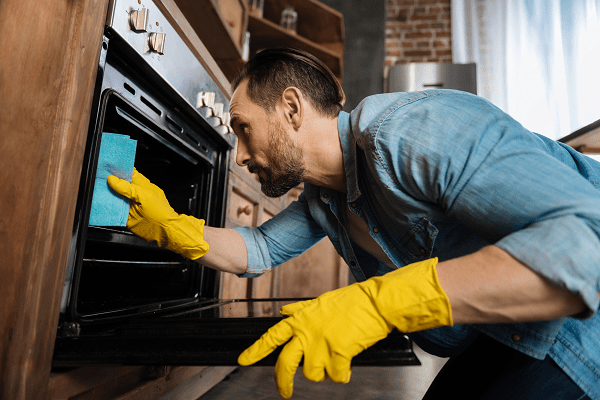Most folks would rather do almost anything else but tackle a grimy oven. Those stubborn layers of food bits, rock-hard grease, and blackened sugar make chemical cleaners look appealing.
Here’s the thing, though—natural options pack quite a punch, too. They get the job done without risking your well-being or harming the planet.
This comprehensive guide explores how to tackle even the toughest oven stains using ingredients you likely already have in your pantry.
Why Burnt Sugar and Grease Are So Difficult to Remove
Ever noticed what happens when you heat sugar past 160°C? It goes through caramelisation, turning into a clingy mess that practically glues itself to metal surfaces in your oven.
Things get worse once it cools down. The stuff hardens like concrete and becomes a real headache to remove.
Fat causes similar problems. When meat drippings or oil splatters hit those high temperatures, they transform chemically, resulting in a stubborn film that regular cleaners barely touch.
These baked-on nuisances do more than just look awful. They can alter how your food tastes, create unwanted smoke during cooking, and even make your appliance less efficient.
Benefits of Choosing Natural Cleaners
Organic solutions offer multiple advantages that extend beyond just getting your oven sparkling clean. Here are some of them:
Health Advantages
Store-bought oven cleaners usually contain some chemicals, with sodium hydroxide being the main component.
This stuff isn’t exactly safe. It can leave you coughing and wheezing, burn your skin if you touch it, send fumes into the air when hot, and spark allergic reactions.
Going natural allows you to sidestep these dangers completely. That’s why homemade solutions work wonderfully in households with little ones, furry companions, or people who struggle with lung issues.
Environmental Impact
Opting for natural formulas reduces chemical runoff into water systems and cuts down on packaging waste. This choice also minimises the carbon footprint associated with manufacturing and transport, significantly decreasing indoor air pollution.
Cost Effectiveness
Most natural cleaning components cost a fraction of store-bought solutions and deliver comparable results.
With just a £5 box of baking soda and that £3 bottle of vinegar sitting in your pantry, you’ll be amazed how many times you can tackle that grimy oven.
Compare this to spending £10-15 on a single container of commercial product that disappears quickly, and the savings will immediately become clear.
Preparation
Proper preparedness makes a significant difference in your results. Take out the racks and wash them separately in the sink or shower.
This provides better access to the interior and prevents grime from falling onto freshly treated areas. Vacuum loose debris before applying any cleaning agent to prevent scratching surfaces during the process.
Consider slightly warming the oven to about 60°C, then turning it off before applying your treatment. This enhances the effectiveness of natural ingredients and also helps with loosening solidified residues.
Natural Ingredients and Solutions
Rather than purchasing expensive and potentially harmful chemical formulations, you can create effective concoctions from items already in your cupboard.
Basic Baking Soda Paste
This gentle powder tackles buildup without leaving scratches and fights acidic food stains, which makes it an amazing natural oven cleaner.
Its alkaline nature breaks apart proteins and greasy spots. This is pretty handy for freshening and eliminating smells.
Creating your cleaner couldn’t be simpler. Mix half a cup of baking soda with just enough water (roughly 3-4 tablespoons) until you get a consistency that spreads easily. Take out all removable parts and clear loose bits first.
Then, coat the interior, but steer clear of heating elements. Now comes the waiting game. Let this mixture sit undisturbed for 12 hours or overnight. During this time, it will absorb odours and slowly dissolve the stuck-on gunk.
For the final step, grab a damp microfibre cloth to wipe everything clean. Do you have some extra stubborn patches? A plastic scraper will work wonders without damaging the surface.
Vinegar-Boosted Solution
Vinegar packs quite a punch with its 5-8% acetic acid content, making it brilliant at slicing through grease, wiping out mineral deposits, and banishing bacteria.
To tackle that stubborn grime, oven cleaning specialists suggest first spreading a simple soda paste across the surface. Let it sit for a bit—around 30 to 60 minutes until slightly dry.
Then comes the satisfying part: Spray white vinegar over it and watch as the alkaline soda meets acidic vinegar, creating a fizzy reaction that lifts even the most stubborn residue from your oven surfaces. Let this combination work for 6-12 hours before wiping it clean.
This method particularly excels at breaking down accumulated oils and fats that have hardened over time.
Lemon Salt Scrub
For burnt sugar specifically, lemon juice offers superior results. As a natural acid, citrus extract dissolves grime and leaves behind a fresh scent.
Begin by preheating the unit to 120°C, then turn it off. Squeeze the juice of two lemons into a heat-safe bowl and mix with a quarter cup of salt to create a paste.
Place a dish of hot water inside, apply the lemon-salt concoction onto the dirty areas, and close the door for 30 minutes.
The vapour will loosen the residue, while the citric acid is going to break down the caramelised sugar. Afterwards, scrub the treated sections with a non-abrasive pad and wipe them clean.
Deep-Clean Combination
For ovens that have not been tended to in months, combine baking soda, liquid castile soap, white vinegar, and, optionally, ten drops of lemon essential oil. Add just enough water to form a spreadable mix.
Apply this blend generously and leave it for a full 24 hours, giving the solution time to penetrate multiple layers of accumulation.
Wipe the oven with warm water and a microfibre cloth, applying a second layer to particularly resistant patches if necessary. This all-in-one solution addresses grease, burnt sugar, and general grime simultaneously.
Application Tips
Using the right tools ensures better results without harming your appliance. Silicone spatulas work well for applying pastes without scratching finishes. Soft-bristled brushes also work the cleansers into these hard-to-reach corners.
Work methodically from the top down to avoid drips creating new messes. Pay extra attention to trouble spots by applying additional paste to the edges where grease and burnt sugar tend to gather.
Don’t overlook often-neglected parts like door hinges and rubber seals, which collect significant dirt that affects performance and efficiency.
Final Touches
To take your efforts to the next level, try a steam finish. Just pop an oven-safe container with water and several lemon slices inside. Heat everything to 120°C for half an hour, then let the oven cool completely before wiping it down.
The gentle vapour works wonders on leftover grime. Plus, those lemon slices leave behind a fresh aroma that beats any chemical cleaner.
If you’re struggling with cloudy glass panels, mix some baking soda and vinegar, spread it right on the glass, and wait just 15 minutes. Wipe it away, and watch it shine like new.
Here’s a clever trick most people miss: Once everything’s clean, rub a thin coconut oil layer onto the racks. This will create a barrier against future messes.
Prevention Strategies
Place oven-safe silicone mats or lined baking sheets on the rack below when preparing potentially messy dishes like bubbling casseroles or pies. These catch drips before they hit the oven floor.
For roasting meats, always use appropriately sized pans to contain splatters and juices.
Address spills promptly whenever possible. A quick wipe with a vinegar solution while the device is still slightly warm but not hot prevents substances from hardening into difficult residues.
Conclusion
Give your dirty oven a complete makeover today. Using only basic kitchen staples, you’ll easily defeat stubborn burnt residue and grease that’s been lingering for months.
Say goodbye to that burnt smell filling your kitchen. Your space will feel fresher, and your dishes will taste exactly as intended.
Best of all, you’ll keep some extra money in your pocket while protecting your loved ones from dangerous chemical cleaners. Why not start right now? Grab that baking soda and bring your old, dirty oven back to life!




